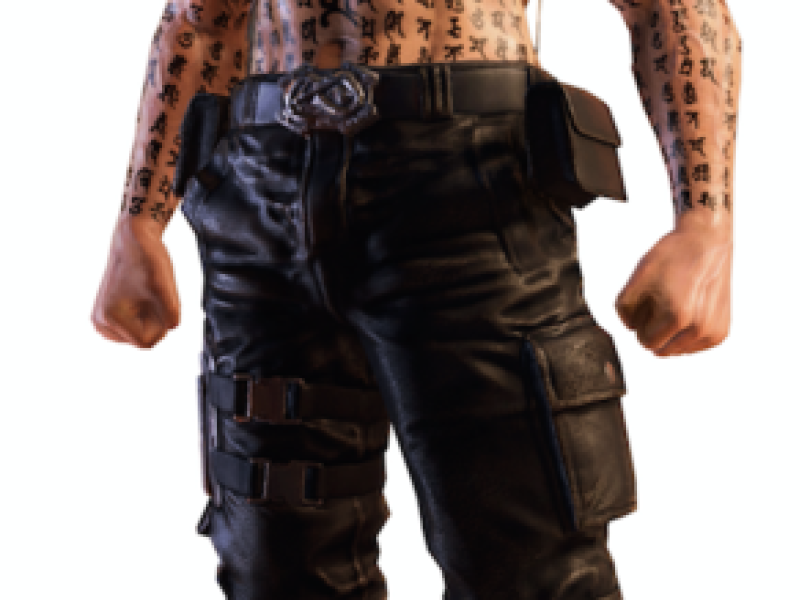Devil’s Third opens boldly with your hero–a Russian Vin Diesel lookalike called Ivan who is permanently topless and covered in Japanese tattoos–playing a drum solo in his cell in Guantanamo Bay while a riot ensues throughout the rest of the camp. Why has he been locked up in Gitmo? “TERRORISM”, says his on-screen bio.
Despite this, he’s apparently good friends with some guy in charge of the facility who sets him free to quell the riot. He does this by murdering everyone in sight with his fists, or a pipe, while occasionally getting attacked by swarms of vampire bats.
Devil’s Third is an action game that combines elements of melee combat–as per director Itagaki’s previous work on the critically-acclaimed post-reboot Ninja Gaiden franchise–and cover-based shooting from both third- and first-person perspectives.
Unfortunately, while the freedom and precision of movement in 2004’s Ninja Gaiden was wondrous, Devil’s Third’s melee combat feels unresponsive and clunky by comparison. There’s none of the careful consideration of your use of space and movement, no moveset to learn inside-out to ensure you cut everyone down with breathtaking efficiency. Instead, Devil’s Third invites you to just wade in and mash the attack buttons until everyone is dead, with action occasionally punctuated by a comically violent execution animation. The ability to dodge and block incoming attacks is available, but seldom used due to most of the enemies offering no tells of their next move.

As you might expect from a man who runs around waging war with no shirt on, Ivan can’t absorb a huge amount of punishment. Often it only takes one or two enemies to get the drop on you and it’s do svidaniya, comrade. This isn’t an issue in and of itself, of course–the likes of Dark Souls or God Hand succeed, and indeed thrived, by using a more vulnerable protagonist–but unfortunately it doesn’t work so well when enemies are capable of literally dropping in out of thin air.
At times, you are punished because the game does not understand its own rules. While Ivan can snap to nearby cover with some degree of reliability, enemies will often land shots at him even when you’d swear blind that they shouldn’t be able to. Worse still, you’ll occasionally see enemies shooting at you through their cover, never mind your own, and the controls occasionally become unresponsive as if you’re dealing with some kind of simulation of online lag.
Because Devil’s Third throws both gun-toting and melee enemies at you at the same time, so much hinges on a seamless transition between the two combat styles, theoretically creating interesting situations where the player is constantly forced to adapt. In reality, there is a slight but absolutely crucial delay when switching between your gun and melee weapon, leading to poor Ivan getting repeatedly shot or stabbed while he fumbles around with the various instruments of death magically stuck to his entirely nude back. Indeed, you’ll frequently find yourself trying to gun down sword-wielding foes, or sprint at someone with a hammer while he fills you with bullets, purely because it often feels like the delay when switching weapons is more likely to get you killed than using the wrong style of combat.
“Control issues, combined with Ivan’s frailty, often make combat a joyless and frustrating experience.”
While Devil’s Third may raise a smile with its self-aware sense of humour, the control issues–combined with Ivan’s frailty–often make combat a joyless and frustrating experience.
The game also tries to alter the pace occasionally, including one section where you have to use Ivan’s infra-red sunglasses to detect anti-personnel mines. This section, though brief, is tedious in the extreme as it simply involves creeping through a warehouse at a snail’s pace while shooting the occasional mine. Worse still, the mines are reintroduced with no warning at all after a few battles, implying that the player is expected to keep the sunglasses activated and patiently crawl through the rest of the level, just in case.
Devil’s Third does offer some welcome respite with its inventive multiplayer modes. As well as shooting at each other or hitting each other with hammers, players can also find themselves herding brightly-coloured chickens or collecting fruit and hurling it into a giant blender. And yet, because of the control issues shared with the main campaign, it’s difficult to envisage players taking the game seriously in the long term, despite the multiplayer modes’ initial charm.






Worse still, as the multiplayer component of the game is being released for free on PC, the microtransactions and currency system of a free-to-play game are entirely present in the Wii U version. This allows players to buy their way to the more expensive weapons with real money if they so wish, which will surely infuriate players who are quite reasonably unwilling to do so.
Despite the occasional laughs and wonderfully weird multiplayer modes, Devil’s Third is near-impossible to recommend. The numerous issues with the controls as well as crucial elements of the game’s combat systems soon mount up to provide an experience that frustrates far more often than it entertains, resulting in a missed opportunity for what could’ve been a cult hit.


